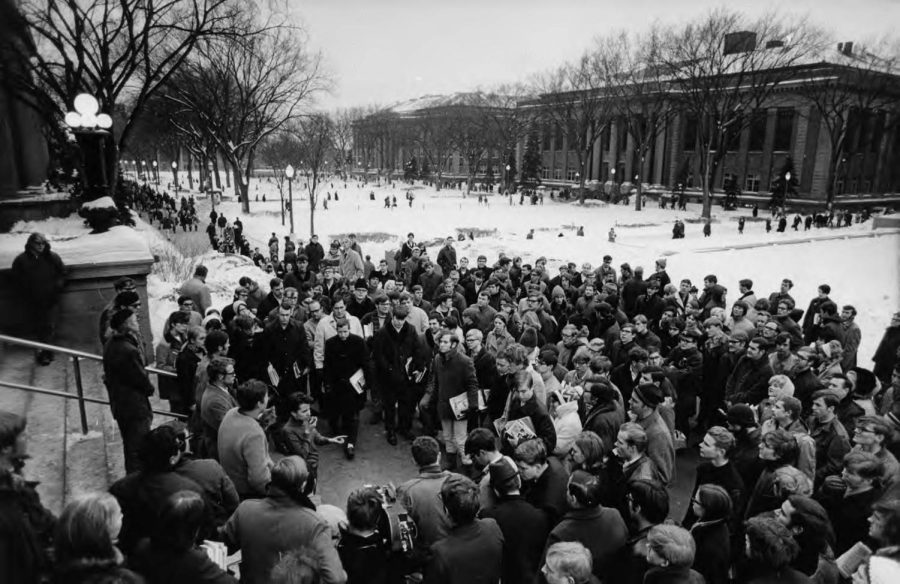The ice at Ridder Arena was dull and dirty the morning of Jan. 31. Adam Stirn, the University of Minnesota’s lead ice maker, doesn’t like dirt; not in hallways, not on rink boards and especially not on ice.
Dirty ice not only looks bad, but makes for rough skating and dull hockey skates and Zamboni blades.
Stirn was preparing to take out the Zamboni – which he calls a “zam” – before the women’s hockey practice, when his coworker stepped off the ice and asked if he was ready for his trip to the Winter Olympics.
“I’m a little nervous,” Stirn said. “I mean, I’m super confident in my ability. It’s just the whole being-away-from-here thing. I’m not really one for month-long trips.”
Stirn is one of just 16 ice makers worldwide selected to work for the 2018 Winter Olympics in Pyeongchang, South Korea. He will spend February making and maintaining the world’s highest-quality hockey ice for the world’s best athletes. Those who know Stirn say they are not surprised he was picked for the job. To them, his attention to detail and years of experience have prepared him for nearly a month of intensive work.
Paying dues over a career on the ice
But before he could go, Stirn had more immediate concerns than his upcoming trip across the globe — the ice at Ridder was still dirty and it was getting dehydrated. Stirn hopped into the Zamboni driver’s seat, and the machine rumbled to life.
“I fell in love with working at the ice arena,” Stirn said. “The whole aspect of being around sports… [and] the freedom of so many different things going on. The days move by pretty fast.”
Stirn applied for his first ice-making job while studying criminal justice at Ferris State University in Big Rapids, Michigan. In 2012, he moved to the University to take over its ice operations. He also works part-time at the Xcel Energy Center for the Minnesota Wild.
Stirn has built a strong reputation among those who observe his work the most. Gopher women’s hockey head coach Brad Frost called him an “incredible professional,” and Craig Flor, Stirn’s University supervisor, said he was not surprised Stirn’s name came up for the Olympics since he is a “great asset” to the team.
An official from the Olympics searching for ice-making recruits called Stirn’s supervisor at the Xcel Energy Center in the fall, and he referred Stirn. The offer fulfilled Stirn’s long-time “pipe dream” of making Olympic ice.
The team was selected based on references, skill and attitude, said Don Moffat, chief ice maker for the Olympics.
“It’s really about personality and teamwork,” he said. “Our days are crazy long, so we really want to have positive people.”

After several months of planning and paperwork, Stirn boarded a flight to South Korea Sunday and will not return until after the gold medal hockey game at the end of the month. He said he has never crossed the Atlantic Ocean, and the prospect of experiencing a new culture and the world’s biggest sporting event is both exciting and nerve-wracking.
All in the details
For Stirn and the other ice makers, the job is one of fine details.
If ice is too soft, it can make pucks bounce and poses a higher risk of injury to skaters. If ice is frozen with too much oxygen, it is prone to cracking and chipping. Experienced skaters can gauge ice quality in an instant, and athletes and coaches often aren’t afraid to voice complaints.
Stirn said Zamboni driving is a balancing act.
Shave off too much ice, and the snow tank fills up too fast, requiring an extra trip off the rink to clear it out. Use too much water, and the supply runs out. Scrape or spray too little, and the ice won’t be sufficiently smoothed.
The sharp blade behind the Zamboni shaves off about 1/32 an inch of ice to smooth the rink and keep it level. A snow tank gathers the shavings, and one stream of water cleans the ice while another forms a thin layer behind the Zamboni, leaving a glossy, smooth path of resurfaced ice.
Ice makers not only drive Zambonis, they also monitor refrigeration systems, manage air conditions inside the building and make repairs.

For those who know his work, Stirn’s attention to detail sets him apart.
“He’s always looking for little things and making sure it’s perfect,” said Craig Flor, Stirn’s supervisor at Ridder and 3M Arena at Mariucci.
Driving the Zamboni makes up a small portion of Stirn’s day. He and the team have to maintain the machine, Flor said, and keep a close eye on the ice plant that runs the refrigeration system.
The labyrinth of green pipes keeps the ice cool, pumping up to 10,000 pounds of refrigerant through approximately 9 miles of pipe laid underneath the rink if the temperature rises too high. At $20-$30 a pound, a refrigerant leak would be a physical and financial disaster, Stirn said, so the crew monitors the apparatus closely.
“If that [ice plant] goes down, then we’re in a world of hurt,” Flor said. “That’s the bread and butter of an ice rink.”
From ‘Thingamajig’ to $100,000 behemoth
Recently, the University purchased a new Zamboni for Stirn and his team.
The University’s brand-new machine replaced a 25-year-old model which was old, rusty and messy. The new machine is boxy yet sleek, and a rainbow blends across its three exposed surfaces. The updated, user-friendly device was a necessity, Stirn said, and well-worth the nearly-$100,000 price tag.
But over 65 years ago, Zambonis were still an emerging technology.
The first Zamboni ice resurfacer was invented in 1949 by Frank Zamboni, the owner of a southern California skating rink. At the time, workers resurfaced ice by hand with squeegees and tractors, said Eric Dregni, a professor at Concordia University-St. Paul and the author of “Zamboni: The Coolest Machines on Ice.”
Zamboni set out to make ice resurfacing fast and easy. He rigged up a Jeep and named it the Thingamajig, Dregni said. After several years of experimentation, the Zamboni was born and soon launched into the international market, he said.
The entrance of a Zamboni between hockey periods – slow circles of a humming machine, gleaming strips of near-perfect ice – offers a break from the aggressive, fast paced sport, Dregni said.
An Olympic adventure
As a general rule, Stirn avoids ice rinks outside of work. He finds himself analyzing ice quality even when he’s off the clock.
“People ask me, ‘Do you still play hockey? You loved hockey,’ and I’m like, ‘I live with it every day. I don’t want to be here [outside work],’” Stirn said. “’Get me home, somewhere warm.’”
But Stirn will make an exception in Pyeongchang to learn more about ice-making for the other sports he won’t work on. Figure skating ice is softer than hockey ice, for example, and speed-skating ice uses a super-sized Zamboni to cover the extra-large tracks.
“I am excited for the culture, to see how this different culture carries themselves,” he said. “That’s probably what I’m looking forward to the most.”
However, he likely won’t have much time off to explore. Don Moffat, lead ice maker at the Olympics, said the crew will be working long days to ensure the rinks are ready for hockey games three times a day.
It’s an opportunity Stirn hopes he will have again.
“I’m hoping maybe this will set me up for the future,” he said. “You never know.”













